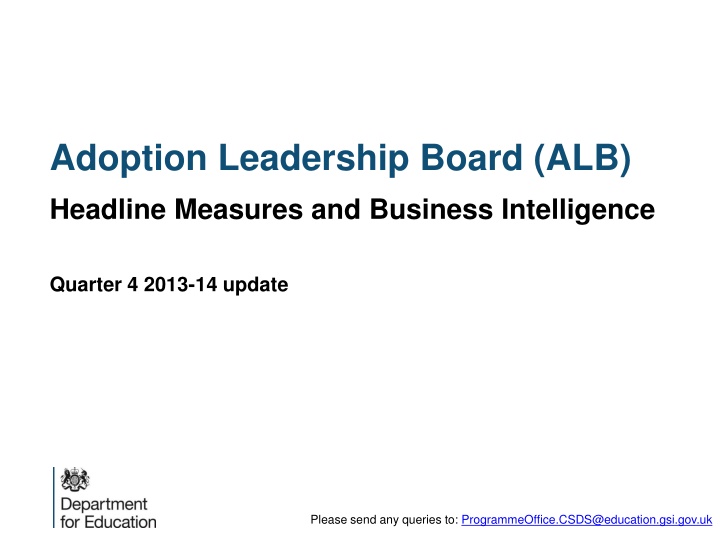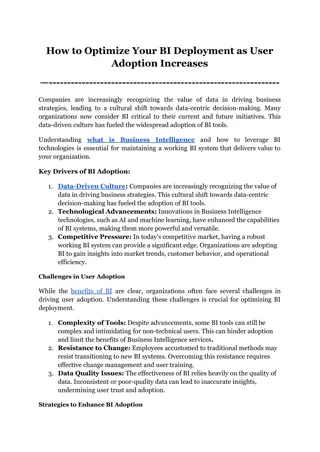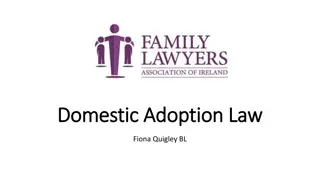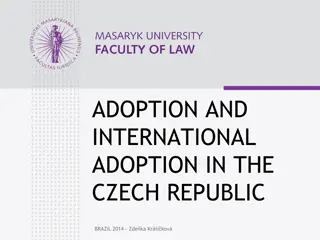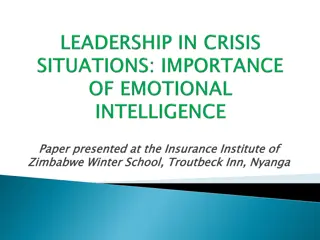Adoption Leadership Board (ALB) Headline Measures and Business Intelligence Update Q4 2013-14
Analysis of the latest data from the Adoption Leadership Board (ALB) for Q4 2013-14 reveals key findings on children waiting for placement, adopter gap, and child timeliness. The data shows improvements in some areas but highlights the ongoing need for more adopters to close the gap. Quarterly survey results indicate progress in certain metrics while emphasizing the importance of timely adoptions for children in care.
Download Presentation

Please find below an Image/Link to download the presentation.
The content on the website is provided AS IS for your information and personal use only. It may not be sold, licensed, or shared on other websites without obtaining consent from the author.If you encounter any issues during the download, it is possible that the publisher has removed the file from their server.
You are allowed to download the files provided on this website for personal or commercial use, subject to the condition that they are used lawfully. All files are the property of their respective owners.
The content on the website is provided AS IS for your information and personal use only. It may not be sold, licensed, or shared on other websites without obtaining consent from the author.
E N D
Presentation Transcript
Adoption Leadership Board (ALB) Headline Measures and Business Intelligence Quarter 4 2013-14 update Please send any queries to: ProgrammeOffice.CSDS@education.gsi.gov.uk
Data sources Figures relating to 2012-13 have been derived using the SSDA903 data (for children) and Ofsted data (for adopters). Figures relating to 2013-14 have been derived using quarterly surveys of local authorities and voluntary adoption agencies. Annual SSDA903 data characteristics and their dates for each stage of the care process, including adoption. The data goes through thorough quality assurance and local authorities are able to update their historic data annually. We therefore view this as the most robust source of information on adoption. It is used to produce the Looked After Children statistical first release (SFR) and the Adoption Scorecards. The latest data covers the 2012-13 financial year. Data for 2013-14 will be published in the SFR on 30 September 2014. Local authorities provide data on their looked after children using the SSDA903 collection. Data are collected from all local authorities. The information is collected at child level and includes information about the child s Quarterly survey This pack includes new quarterly data covering the final quarter of 2013-14. This is the first time we have been able to make estimates for 2013-14 based on actual full-year data. This quarter s collection marked the first time responsibility for quarterly surveys moved from DfE to the ALB. The form sent to local authorities included new variables, the biggest change being that adopter data was requested at adopter level (previous collections asked for this aggregated to LA level). This was also the first time voluntary adoption agencies (VAAs) were asked for the same adopter information as LAs. The response rate is promising, with 119 LAs (79%) returning in quarter 4 2013-14, an improvement on quarter 3 (69%). Estimates for 2013-14 are based on data provided by LAs who returned in all four quarters of the year. Therefore the latest analysis includes 53% of local authorities. The exception to this is the adopter timeliness information which was not collected in the same way in previous collections, and so in order to exploit the higher response rate we have included all LAs who returned in quarter 4 2013-14. Ofsted data Ofsted publish annual data on the recruitment of adopters and the children placed with them. Data is collected on both local authority recruitment and voluntary adoption agency recruitment. We include information on adopter timeliness taken from this collection in this pack.
Latest data Key findings for the four headline measures are: Children waiting The number of children with a placement order waiting to be placed The latest annual data shows that there were 6,000 children with a placement order waiting to be placed with an adoptive family as at 31 March 2013. Quarterly data suggests that there has been a 24% decrease to 4,550 at the end of 2013-14. The number of new placement orders granted has decreased since quarter 2 2013-14, falling by 46% (from 1,570 to 850) to quarter 4. The number of new decisions has also decreased since quarter 2, falling by 39% (from 1,800 to 1,100) to quarter 4. Adopter Gap The The difference difference between order order waiting waiting to between the to be be placed placed and the number number of and the the number of adopters adopters needed number of of adopters adopters waiting needed for waiting to for children children with to be be matched matched with a a placement placement Our most recent estimate for the adopter gap suggests we need to approve 3,100 more adopters to close the gap. Child Timeliness The average time between a child entering care and moving in with their adopted family The latest adoption scorecards show that child timeliness had not improved since the previous round. Quarterly data suggests there has been an improvement in 2013-14 (down 12% from 658 days in 2012- 13 to 581 days in 2013-14). This is encouraging but is still 34 days above the threshold and the three- year average will be higher. Adopter timeliness The The average average time adopter adopter to to a a child time between between an child moving moving in an adoption adoption agency in to to their their home home to agency receiving receiving an to be be adopted adopted an application application from from a a potential potential Latest quarterly data suggests adopter timeliness has improved since 2012-13: the proportion of applications approved within 6 months in quarter 4 2013-14 was 35%. This compares to 27% of decisions being made within 6 months of applications in 2012-13. The proportion of approved adopters matched within 6 months of approval in quarter 4 2013-14 was 78%, compared with 69% in 2012-13. Timeliness from application to approval has, however, been declining since quarter 2 2013-14.
Please note there is currently a comparability issue between the annual and quarterly data with regards to the children waiting with a placement order measure. The quarterly data excludes children with an ADM decision reversal. Comparing the 4,550 quarter 4 2013-14 figure with quarterly data from the same quarter in 2012-13 suggests the fall in children waiting with a placement order was 17%, not 24%. 1. Children waiting Children Children waiting with a waiting with a placement placement order order The number of new placement orders granted has decreased since quarter 2 2013-14, falling by 46% (from 1,570 to 850) to quarter 4. The latest annual data shows that there were 6,000 children with a placement order waiting to be placed with an adoptive family as at 31 March 2013. Quarterly data suggests that there has been a 24% decrease to 4,550 at the end of 2013-14. Children Annual data shows that there were around 6,890 children with a decision that adoption was the best option who had not yet been placed with an adoptive family as at 31 March 2013. Quarterly data suggests that there has been an 11% decrease to 6,160 by the end of 2013-14. waiting with a decision The number of new decisions has decreased since quarter 2, falling by 39% (from 1,800 to 1,100) to quarter 4. However, having increased during the first two quarters of the year, the total number of decisions in 2013-14 is still slightly higher than expected. Children with a decision who had not yet been placed by the end of March 2014 had on average entered care 22 months before (a decrease of 3 months from those waiting at the end of quarter 4 2012-13). This average is beyond the current threshold set in the adoption scorecards of 20 months. Waiting times by characteristics
2. Adopter Gap The adoptergap is measured by calculating the gap between the number of adopters needed for children with a placement order who have not yet been placed and the number of approved adopters not yet matched with children. We estimate that this was 3,100 at the end of 2012-13. Adopter gap Adopter recruitment 7,160 6,590 to LAs and 570 to VAAs. The key components of the adopter gap are: applications in 2013-14 Information is not available for VAAs for 2012-13, but applications to LAs increased by 51% compared to 2012-13 from 4,360. 2011 2011- -12 12 2012 2012- -13 13 VAA adopters not yet matched 100 200 LA adopters not yet matched 1,900 1,600 5,450 This is an increase of 32% from 4,120 in 2012-13. LA approvals increased by 31% (3,490 to 4,570) and VAA approvals increased by 40% (620 to 880). approvals in 2013-14 Total adopters not yet matched 2,100 1,800 Children not yet placed 5,200 6,000 Number of adopters needed 4,000 4,900 Adopter gap Adopter gap 2,000 2,000 3,100 3,100 New 2 Stage Process 37% of approvals in quarter 4 2013-14 were made using the new two stage process. (38% in LAs, 29% in VAAs). The new process is quicker Approvals via the new process were 10 weeks quicker than those approved via the old process in quarter 4 2013-14. Stage 1 takes 9 weeks Stage 2 takes 16 weeks For adopters approved through the new process, the average time taken to complete stage 1 was 62 days (9 weeks) whilst stage 2 took 113 days (16 weeks).
3. Child Timeliness The latest adoption scorecards show that child timeliness had not improved since the previous round. Quarterly data suggests there has been an improvement in 2013-14 (down 12% from 658 days in 2012-13 to 581 days in 2013-14). Court makes placement order (i.e. gives LA authority to place) Adoption Order Application made and child is legally adopted (after hearing) LA decides on a match between child and adopter ADM decision in LA made for the child to be adopted Child is placed with adopter Child enters care Average time taken: 11 months Average time taken: 10 months Average time taken: 1 month Average time taken: 9 months These times are derived from the 2012-13 annual data Adoption scorecard Quarterly data The latest round of scorecards, covering 2010-13, showed that: This was not an improvement on the 2009-12 scorecards authorities missed both thresholds (20 months and 6 months respectively). Latest quarterly data suggests that timeliness is improving: and 65 local The average time between a child entering care and moving in with its adoptive family (indicator A1) was 647 days (or 22 months). The chart below shows performance on indicator A1 in 2013-14. At 581 days this is closer to the 2011-14 threshold (547 days). This is encouraging but this is still 34 days above the threshold and the three-year average Combining the quarterly and annual data suggests a 2011-14 three year average of 624 days. 55% of children waited less than 20 months between entering care and moving in with their adoptive family (indicator A3). The average time between a local authority receiving court authority to place a child and the local authority deciding on a match (indicator A2) was 210 days (or 7 months). will be higher. The placements have improved, there was a 14% improvement in the average time each took from entering care between 2012-13 and 2013-14. timeliness of decisions and
4. Adopter Timeliness The latest quarterly data suggests adopter timeliness has improved since 2012-13. The proportion of applications approved within 6 months in quarter 4 2013-14 was 35%. This compares to 27% of decisions being made within 6 months of applications in 2012-13. The proportion of adopters matched within 6 months of approval in quarter 4 2013-14 was 78%, compared with 69% in 2012-13. Timeliness from application to approval has, however, been declining since quarter 2 2013-14. Ofsted data 2012-13 Application to decision Quarterly data 2013-14 Q4 Application to approval LAs 3,520 VAAs 610 Total 4,130 LAs 1,220 VAAs 170 Total 1,380 Total decisions = Less than 3 months Total approval = Less than 3 months 6% 24% 38% 20% 10% 3% 3% 12% 46% 22% 12% 4% 5% 22% 39% 20% 10% 3% 5% 32% 45% 11% 6% 2% 7% 15% 61% 11% 4% 1% 5% 29% 47% 11% 6% 1% 3 months but less than 6 months 6 months but less than 9 months 9 months but less than 12 months 12 months but less than 18 months 18 months or more 3 months but less than 6 months 6 months but less than 9 months 9 months but less than 12 months 12 months but less than 18 months 18 months or more Approval to match Approval to match LAs 3,170 42% 29% 13% VAAs 520 15% 40% 23% 12% Total 3,690 38% 31% 15% LAs 780 49% 30% 10% 6% 3% 2% VAAs 120 20% 53% 14% Total 900 45% 33% 11% Total matches = Less than 3 months Total matches = Less than 3 months 3 months but less than 6 months 6 months but less than 9 months 9 months but less than 12 months 12 months but less than 18 months 18 months or more 3 months but less than 6 months 6 months but less than 9 months 9 months but less than 12 months 12 months but less than 18 months 18 months or more 7% 4% 4% 7% 5% 4% 6% 3% 3% 6% 3% 2% 6% 3% The average number of days between application and approval in quarter 4 2013-14 in England was 222 days, whilst the average number of days from approval to match was 131 days.
Contextual information There were 68,110 children looked after at 31 March 2013. 5% had been placed for adoption whilst three quarters were in foster placements. 3,980 children were adopted during 2012-13 - up 15% from 2011-12. This is the highest number of adoptions since the current data collection began in 1992. Quarterly data suggests that 4,960 children were adopted in 2013-14, an increase of 25% on 2012-13. There were 4,560 children placed for adoption during 2012-13. Quarterly data suggests that the number of children placed during 2013-14 was 5,210, an increase of 14% on 2012-13. The majority of children placed for adoption were in care due to abuse or neglect (70%). This was higher than all children looked after at 31 March 2013 (62%) There were 600 children adopted by their foster carers during 2012-13. This was 15% of all adopted children. There were 970 reversals of decisions to place a child for adoption during 2012-13. Reasons for these were: 27% 10% 37% 26% The child s needs changed subsequent to the decision The Court did not make a placement order Prospective adopters could not be found Any other reason
